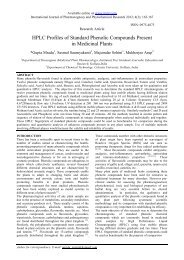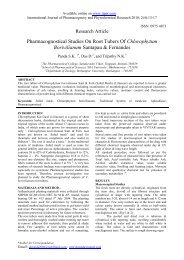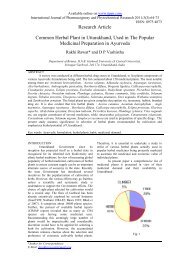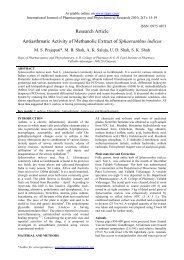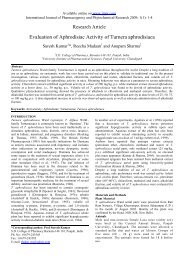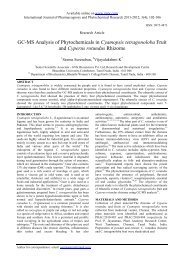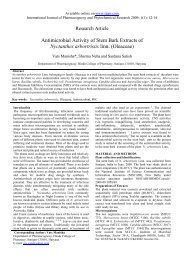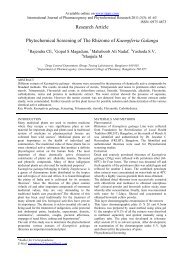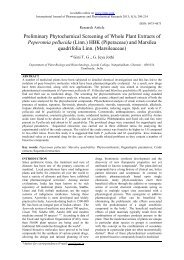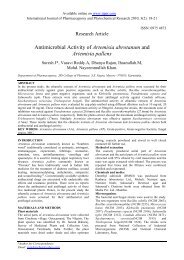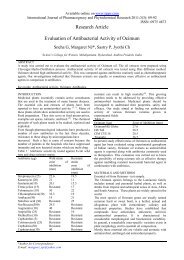Full Text PDF - International Journal of Pharmacognosy and ...
Full Text PDF - International Journal of Pharmacognosy and ...
Full Text PDF - International Journal of Pharmacognosy and ...
You also want an ePaper? Increase the reach of your titles
YUMPU automatically turns print PDFs into web optimized ePapers that Google loves.
Umadevi U., Kamalam M / Pharmacognostical, phytochemical <strong>and</strong>…<br />
Plate 4<br />
Chromatogram <strong>of</strong> Glycosides using HPTLC<br />
Sample 1-acetone extract <strong>of</strong> leaf<br />
Sample 5-waterextract <strong>of</strong> stem<br />
Sample 2-acetone extract <strong>of</strong> stem<br />
Sample 6-water extract <strong>of</strong> tuber<br />
Sample 3-acetone extract <strong>of</strong> tuber<br />
STE- Stevioside St<strong>and</strong>ard<br />
Sample 4-water extract <strong>of</strong> leaf<br />
RUT- Rutin St<strong>and</strong>ard<br />
QUE- Quercetine St<strong>and</strong>ard<br />
Table 4: Variation in metal contamination pattern in soil <strong>and</strong> different parts <strong>of</strong> C.epigaeus<br />
Name <strong>of</strong> the metals Leaf Stem Tuber<br />
Lead 0.1 Nil Nil<br />
Copper 1.0 0.65 0.25<br />
Chromium 7.41 3.18 2.12<br />
Cadmium Nil Nil Nil<br />
materials for the finished products may be checked for<br />
the presence <strong>of</strong> heavy metals, pesticides, bacterial or<br />
fungal contamination 12 . Heavy metal analysis revealed<br />
that lead is found only in leaf powder (0.1ppm) <strong>and</strong><br />
copper <strong>and</strong> chromium were found in the leaf, stem <strong>and</strong><br />
tuber powder (Table 4). Chromium is found to be<br />
present higher than copper but all the metals present were<br />
lower than the permissible level (Pb-10ppm, Cu-20ppm<br />
<strong>and</strong> Cr-50-200 µg). Cadmium was totally absent in all the<br />
samples studied. To conclude, the present investigations<br />
revealed that the therapeutic use <strong>of</strong> this plant species will<br />
not cause any heavy metal toxicity <strong>and</strong> may be beneficial<br />
to the users in case oral administration.<br />
CONCLUSION<br />
Pharmacognostical studies reported that the plant<br />
constituents are mostly water soluble <strong>and</strong> contains most<br />
<strong>of</strong> the secondary metabolites that are responsible for<br />
curing various ailments. Heavy metal studies also<br />
revealed that the plant is safe for oral consumption.<br />
Further quantitative phytochemical <strong>and</strong> pharmacological<br />
studies are undergoing to explore the medicinal efficacy<br />
<strong>of</strong> this plant.<br />
ACKNOWLEDGEMENT<br />
The First author acknowledges UGC for providing fund<br />
to carry out this project work.<br />
REFERENCES<br />
1. Jain, S.K., Ethnobiology for human welfare, Deep<br />
publication, NewDelhi, 1991.<br />
2. Pullaiah, T., Encyclopedia <strong>of</strong> world Medicinal plants,<br />
Regency Publlication, II, 2006; 634-635.<br />
3. Sara Oldfield, Cactus <strong>and</strong> Succulent Plants: Status<br />
survey <strong>and</strong> Conservation action plan, IUCN/SSC<br />
Cactus <strong>and</strong> Succulent specialist group, IUCN<br />
Publications Services Unit, Cambridge, 1997; 188.<br />
4. Choudhary, K., Singh, M., <strong>and</strong> Pillai, U.,<br />
Ethnobotanical Survey <strong>of</strong> Rajasthan - An update,<br />
American – Eurasian <strong>Journal</strong> <strong>of</strong> Botany. 2008; 1 (2):<br />
38-45.<br />
5. Atal, C.K., <strong>and</strong> Kapur, B.M., Cultivation <strong>and</strong><br />
Utilization <strong>of</strong> Aromatic plants, Regional research<br />
laboratory, CSIR, Jammu –Tawi, 1982.<br />
6. Anitha, G., Kamakshamma, J., Prasad Babu, G., <strong>and</strong><br />
Sundarsanam, G., Phytochemical investigation <strong>and</strong><br />
antimicrobial activity in selected medicinal plants,<br />
Proce: <strong>International</strong> seminar on medicinal plants <strong>and</strong><br />
herbal products. 2008; 34.<br />
7. Kingston, C., Jeeva, G.M., Kiruba, S., Mishra, B.P<br />
<strong>and</strong> Kannan,D., Indigenous knowledge <strong>of</strong> using<br />
medicinal plants in treating skindiseases in<br />
Kanyakumari district, Southern India, Indian <strong>Journal</strong><br />
<strong>of</strong> Traditional knowledge, NISCAIR, CSIR, New<br />
Delhi, India. 2009; 8 (2) 197.<br />
8. Kokate, C.K., Practical <strong>Pharmacognosy</strong>, Narali<br />
prakashnan, 2005; 107-109.<br />
9. Nisha shri, C., Balaji, S., Venkatramanan, S., <strong>and</strong><br />
Madhumathi, K.L., Pharmacognostical <strong>and</strong><br />
preliminary phytochemical screening <strong>of</strong> the root <strong>and</strong><br />
rhizome <strong>of</strong> Corallocarpus epigaeus, <strong>International</strong><br />
<strong>Journal</strong> <strong>of</strong> pharmaceutical <strong>and</strong> Biomedicine<br />
research, 2010; 1(1), 24-27.<br />
10. Sovljianski, R., LAzic, S., Mackov <strong>and</strong> Obradovic,<br />
S., Heavy metal contents in medicinal <strong>and</strong> spice<br />
plants cultivated in Yugoslavia, Herba-Hungarica.<br />
1993; 29 (3): 59-69.<br />
Page120<br />
IJPPR, Vol-4, Issue 3, September-November 2012, 117-121



